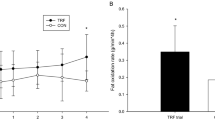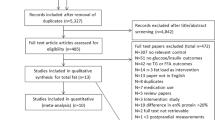Abstract
Objective:
To investigate the effect of Olibra™ fat emulsion on medium-term food intake and appetite in non-obese subjects.
Design:
Double-blind, placebo-controlled, within-subject crossover.
Setting:
University of Ulster, Coleraine.
Subjects:
A total of 28 subjects (14 male, 14 female).
Interventions:
Subjects were randomly assigned to receive either a 200 g portion of test (5 g of Olibra™ fat) or control (5 g milk fat) yoghurt for breakfast for 2 × 3 week ‘study’ phases, separated by a 3-week ‘wash-out’ phase. On days 1, 8 and 22 of the study phases, food intake 4 h post-consumption of the yoghurt was assessed by pre- and post-covert weighing at an ad libitum buffet-style test lunch. Throughout each of these study days, appetite was assessed using visual analogue scales (VAS) at regular intervals. For the remainder of the study days, and the following 24 h (‘post-study days’), subjects reported their food intake using weighed dietary records.
Results:
Consumption of the Olibra™ emulsion had no significant effect on mean energy, macronutrient or amounts of food consumed at the lunch 4 h post-consumption. Self-reported food intakes indicated that there was no significant effect of the emulsion on energy intakes for the remainder of each study day and post-study days. There was considerable individual variation in food intakes following consumption of the Olibra™ emulsion, with 46, 59 and 57% of subjects reducing their energy intakes at lunch on days 1, 8 and 22. There was no consistent effect of the emulsion on appetite ratings.
Conclusions:
In contrast to earlier studies, there was no evidence of a short- or medium-term effect of the Olibra™ emulsion on food intake or appetite. This could be owing to numerous confounding factors influencing eating behaviour and/or the different study design used in the present study.
This is a preview of subscription content, access via your institution
Access options
Subscribe to this journal
Receive 12 print issues and online access
$259.00 per year
only $21.58 per issue
Buy this article
- Purchase on Springer Link
- Instant access to full article PDF
Prices may be subject to local taxes which are calculated during checkout




Similar content being viewed by others
References
Blundell JE, MacDiarmid JI (1997). Fat as a risk factor for overconsumption: satiation, satiety, and patterns of eating. J Am Diet Assoc 97 (Suppl), S63–S69.
Blundell JE, Tremblay A (1995). Appetite control and energy (fuel) balance. Nutr Res Rev 8, 225–242.
Burns AA, Livingstone MBE, Welch RW, Dunne A, Reid CA, Rowland IR (2001). The effects of yoghurt containing a novel fat emulsion on energy and macronutrient intakes in non-overweight, overweight and obese subjects. Int J Obes Relat Metab Disord 25, 1487–1496.
Burns AA, Livingstone MBE, Welch RW, Dunne A, Robson PJ, Lindmark L et al. (2000). Short-term effects of yoghurt containing a novel fat emulsion on energy and macronutrient intakes in non-obese subjects. Int J Obes Relat Metab Disord 24, 1419–1425.
Burns AA, Livingstone MBE, Welch RW, Dunne A, Rowland IR (2002). Dose-response effects of a novel fat emulsion (Olibra™) on energy and macronutrient intakes up to 36 h post-consumption. Eur J Clin Nutr 56, 368–377.
Cotton JR, Burley VJ, Weststrate JA, Blundell JE (1994). Dietary fat and appetite: similarities and differences in the satiating effect of meals supplemented with either fat or carbohydrate. J Hum Nutr Diet 7, 11–24.
de Castro JM, de Castro ES (1989). Spontaneous meal patterns of humans: influence of the presence of other people. Am J Clin Nutr 50, 237–247.
Flegal KM, Carroll MD, Ogden CL, Johnson CL (2002). Prevalence and trends in obesity among US adults, 1999–2000. JAMA 288, 1723–1727.
French S (2004). Effects of dietary fat and carbohydrate on appetite vary depending upon site and structure. Br J Nutr 92 (Suppl 1), S23–S26.
French SJ (1999). The effects of specific nutrients on the regulation of feeding behaviour in human subjects. Proc Nutr Soc 58, 533–540.
Gormally J, Black S, Daston S, Rardin D (1982). The assessment of binge eating severity among obese persons. Addict Behav 7, 47–55.
Harnack LJ, Jeffery RW, Boutelle KN (2000). Temporal trends in energy intake in the United States: an ecologic perspective. Am J Clin Nutr 71, 1478–1484.
Heitmann BL, Lissner L, Osler M (2000). Do we eat less fat, or just report so? Int J Obes Relat Metab Disord 24, 435–442.
Lawton CL, Delargy HJ, Brockman J, Smith FC, Blundell JE (2000). The degree of saturation of fatty acids influences post-ingestive satiety. Br J Nutr 83, 473–482.
Livingstone MBE, Prentice AM, Strain JJ, Coward WA, Black AE, Barker ME et al. (1990). Accuracy of weighed dietary records in studies of diet and health. BMJ 300, 708–712.
McCarthy SN, Gibney MJ, Flynn A, Livingstone MBE (2002). Overweight, obesity and physical activity levels in Irish adults: evidence from the North/South Ireland Food Consumption Survey. Proc Nutr Soc 61, 3–7.
Nielsen SJ, Popkin BM (2003). Patterns and trends in food portion sizes, 1977–1998. JAMA 289, 450–453.
Poppitt SD, McCormack D, Buffenstein R (1998). Short-term effects of macronutrient preloads on appetite and energy intake in lean women. Physiol Behav 64, 279–285.
Rolls BJ (1985). Experimental analyses of the effects of variety in a meal on human feeding. Am J Clin Nutr 42, 932–939.
Rolls BJ, Gnizak N, Summerfelt A, Laster LJ (1988). Food intake in dieters and nondieters after a liquid meal containing medium-chain triglycerides. Am J Clin Nutr 48, 66–71.
Rolls BJ, Morris EL, Roe LS (2002). Portion size of food affects energy intake in normal-weight and overweight men and women. Am J Clin Nutr 76, 1207–1213.
Rosenberg M (1965). Society and the Adolescent Self-Image. Princeton University Press: Princeton, NJ.
Shahar DR, Yerushalmi N, Lubin F, Froom P, Shahar A, Kristal-Boneh E (2001). Seasonal variations in dietary intake affect the consistency of dietary assessment. Eur J Epidemiol 17, 129–133.
Sorensen LB, Moller P, Flint A, Martens M, Raben A (2003). Effect of sensory perception of foods on appetite and food intake: a review of studies on humans. Int J Obes Relat Metab Disord 27, 1152–1166.
Stroebele N, De Castro JM (2004). Effect of ambience on food intake and food choice. Nutrition 20, 821–838.
Stubbs RJ, Harbron CG (1996). Covert manipulation of the ratio of medium- to long-chain triglycerides in isoenergetically dense diets: effect on food intake in ad libitum feeding men. Int J Obes Relat Metab Disord 20, 435–444.
van Strien T, Frijters JER, Bergers GPA, Defares PB (1986). The Dutch Eating Behaviour Questionnaire (DEBQ) for assessment of restrained, emotional, and external eating behaviour. Int J Eat Disord 5, 295–315.
Van Wymelbeke V, Himaya A, Louis-Sylvestre J, Fantino M (1998). Influence of medium-chain and long-chain triacylglycerols on the control of food intake in men. Am J Clin Nutr 68, 226–234.
Weber AJ, King SC, Meiselman HL (2004). Effects of social interaction, physical environment and food choice freedom on consumption in a meal-testing environment. Appetite 42, 115–118.
Acknowledgements
This study was funded by Lipid Technologies Provider AB, Stockholm, Sweden. We thank Dr Ian Bradury for his statistical advise.
Author information
Authors and Affiliations
Corresponding author
Additional information
Guarantor: MBE Livingstone.
Contributors: CML: Preparing study design/protocol, practical work, statistical analysis and writing of paper; TAMcC: Practical work, statistical analysis; JMWW: Preparing study design/protocol, reviewing of paper; PJR: Preparing study design/protocol, reviewing of paper; RWW: Preparing study design/protocol, reviewing of paper; AD: Statistical analysis; MBEL: Preparing study design/protocol, reviewing of paper.
Appendix A
Appendix A
Nutrient composition (per 100 g) of foods offered at test meal 4 h post-consumption of the yoghurts (Table A1).
Rights and permissions
About this article
Cite this article
Logan, C., McCaffrey, T., Wallace, J. et al. Investigation of the medium-term effects of Olibra™ fat emulsion on food intake in non-obese subjects. Eur J Clin Nutr 60, 1081–1091 (2006). https://doi.org/10.1038/sj.ejcn.1602422
Received:
Revised:
Accepted:
Published:
Issue Date:
DOI: https://doi.org/10.1038/sj.ejcn.1602422
Keywords
This article is cited by
-
Effects of lipid emulsion particle size on satiety and energy intake: a randomised cross-over trial
European Journal of Clinical Nutrition (2018)
-
No appetite efficacy of a commercial structured lipid emulsion in minimally processed drinks
International Journal of Obesity (2012)
-
No efficacy of processed Fabuless (Olibra) in suppressing appetite or food intake
European Journal of Clinical Nutrition (2011)
-
Effect of a vegetable-oil emulsion on body composition; a 12-week study in overweight women on a meal replacement therapy after an initial weight loss: a randomized controlled trial
European Journal of Nutrition (2011)
-
Long-term effects of consumption of a novel fat emulsion in relation to body-weight management
International Journal of Obesity (2007)



